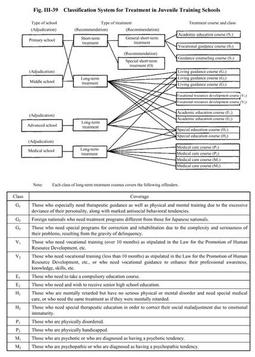| Previous Next Index Image Index Year Selection | |
|
|
1 Overview Juvenile training schools admit persons who have received a family court adjudication for commitment to a juvenile training school as a protective measure. As of April1,2000,52juvenile training schools as well as one branch school had been established nationwide.
In principle, offenders may be legally detained in a juvenile training school until they reach the age of20. When the period between the adjudication for commitment to a juvenile school and the20th birthday of the juvenile in question is less than one year, the superintendent of the juvenile training school may detain the juvenile for one year counting from the date of the adjudication. According to age, the level of tendency toward committing crime, and the physical and mental conditions of juvenile offenders, schools are classified into the following four types: [1]Primary schools(for juveniles aged14or over but less than about16without any serious physical or mental disorder); [2]Middle schools(for juveniles aged about16or over but less than20without any serious physical or mental disorder); [3]Advanced schools(for juveniles aged about16or over but less than23without any serious physical or mental disorder but with a strong tendency toward committing crime);and [4]Medical schools(for juveniles aged14or over but less than26with a serious physical or mental disorder). Males and females are detained separately, except in medical schools. The type of school in which a juvenile is to be detained is decided in family court adjudication. In deciding on commitment to a primary or middle juvenile training school, however, a family court may make a recommendation that short-term treatment(general short-term treatment or special short-term treatment)is appropriate for the juvenile in question. Thus, some juvenile training schools specifically provide short-term treatment, while others specialize in long-term treatment. Short-term treatment is provided for juveniles whose correction and rehabilitation can be expected through continuous and intensive guidance and training for a short period, despite a certain level of tendency toward delinquency. This is because early improvement is deemed likely in light of the simplicity or relative lightness of the offender's problems. Accordingly, this type of treatment is provided in an open atmosphere. For operational purposes, short-term treatment is classified into general short-term treatment, continuing for six months at most, and special short-term treatment, provided for those who are less inclined to delinquency and continuing for four months at most. Long-term treatment is provided for those who are not suitable for short-term treatment. In September1997,operational standards for long-term treatment were reviewed so that juvenile training schools could respond more flexibly to the qualitative escalation of recent juvenile delinquency as well as to the increasing complexity and diversity of juvenile problems. As a result, a new treatment course(G3)was created in light of the complexity and seriousness of juvenile problems as reflected in the gravity of delinquency. The new course, which involves detention of two years or longer in principle, is designed for juveniles who require special treatment for correction and rehabilitation. The review also called for further enhancement of individualized treatment for other juveniles. For instance, the detention period was traditionally limited to two years at most for operational purposes, but superintendents of juvenile training schools may now extend this period as necessary through prescribed procedures in light of the conditions of the juveniles concerned. This classification system for treatment in juvenile training schools is shown in Fig. III-39. Following the adjudication for commitment to a juvenile training school, the juvenile classification home designates a juvenile training school to which the offender should be admitted according to the characteristics of the offender and the necessity of education in light of the treatment courses, etc. , conducted in each training school. Fig. III-39 Classification System for Treatment in Juvenile Training Schools In response to the increasing diversity and complexity of juvenile delinquency, juvenile training schools are working in close contact and cooperation with probation offices and other related organizations with a view to a greater individualization of treatment. The aim is to meet the educational needs of individual juveniles based on their characteristics and problems.Superintendents of juvenile training schools issue a discharge request to the relevant Regional Parole Board when they consider that the goal of correction has been attained for a juvenile. Superintendents issue requests for release on parole to the Board when they consider such measures to be appropriate due to the fact that a juvenile has improved to the highest level of treatment. |
